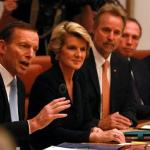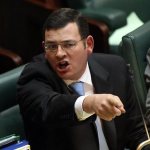 The executive government is perhaps what most people think of as ‘the government’ – the Prime Minister (Federal) or Premier (State) along with his or her ministers. The main functions of executive government are to oversee the administration of the nation or state, to make decisions on a day-to-day basis and to take a lead role in the parliament. While the parliament is supreme in our political system, history also suggests that strong executive government is important for stability, prosperity and security. We look to our executive governments to provide policy, leadership and responsive decision-making, particularly in times of economic uncertainty, external threat or internal emergency. Executive governments develop policies that are generally enacted as legislation, so they play a crucial leadership role in the review, development and passing of laws.
The executive government is perhaps what most people think of as ‘the government’ – the Prime Minister (Federal) or Premier (State) along with his or her ministers. The main functions of executive government are to oversee the administration of the nation or state, to make decisions on a day-to-day basis and to take a lead role in the parliament. While the parliament is supreme in our political system, history also suggests that strong executive government is important for stability, prosperity and security. We look to our executive governments to provide policy, leadership and responsive decision-making, particularly in times of economic uncertainty, external threat or internal emergency. Executive governments develop policies that are generally enacted as legislation, so they play a crucial leadership role in the review, development and passing of laws.
A literal reading of the Commonwealth Constitution (specifically, Section 61) suggests that executive authority in Australia ultimately rests with the Governor-General, while Section 62 orders the formation of a Federal Executive Council to provide the Governor-General with “advice”. In reality, the Governor-General plays little role in executive decision-making, other than ‘rubber-stamping’ laws by granting royal assent. As in Great Britain and other Westminster-style systems, real executive power is instead exercised by the Prime Minister or Premier and their Cabinet. Both these institutions exist by convention: they are not specifically created by or mentioned in the Constitution of Australia. The Cabinet plays a pivotal role in law-making. Federal and State cabinets are responsible for formulating, developing and reviewing policy, most of which is enacted as legislation. The main role of Cabinets is, therefore, to manage the government’s legislative program within the parliament. The Cabinet and its sub-committees also manage the day-to-day business of government and provides an immediate response to disasters or emergencies, such as the Bali bombings (2002) and the Victorian bushfires (2009). Discussions within Cabinet are recorded in minutes but these are kept secret for 30 years.
The current heads of government in the nine Australian jurisdictions, as of August 2020, are as follows:

Federal or Commonwealth: Scott Morrison (prime minister, Liberal Party) and Michael McCormack (deputy prime minister, National Party)
New South Wales: Gladys Berejiklian (premier, Liberal) and John Barilaro (deputy premier, National)
Queensland: Annastacia Palaszczuk (premier, Labor) and Steven Miles (deputy premier, Labor)
South Australia: Steven Marshall (premier, Liberal) and Vickie Chapman (deputy premier, Liberal)
Tasmania: Peter Gutwein (premier, Liberal) and Jeremy Rockliff (deputy premier, Liberal)
Victoria: Daniel Andrews (premier, Labor) and James Merlino (deputy premier, Labor)
Western Australia: Mark McGowan (premier, Labor) and Roger Cook (deputy premier, Labor)
Australian Capital Territory: Andrew Barr (chief minister, Labor)
Northern Territory: Michael Gunner (chief minister, Labor)
© lawgovpol.com 2020. Content on this page may not be republished or distributed without permission. For more information please refer to our Terms of Use.
